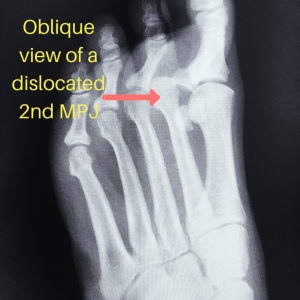
Unicameral Bone Cyst
July 25, 2018
Buddy Tape Your Toe Fracture
August 11, 2018Plantar Plate Injury Resulting in a Dislocated Toe
History of the Plantar Plate Injury
A 74 year old athletic female presented to my clinic today complaining about severe pain to her left forefoot, and a dislocated 2nd toe. The pain had been present for several months; however, after a recent hike in Ouray, CO her symptoms had become excruciating.
Upon arriving back in Salt Lake City 8 days ago, she went to her general MD for treatment. She was diagnosed with a “neuroma”, and a steroid injection was supposingly administered in her 2nd intermetatarsal space. This was the 3rd time that this location was injected with steroid over the past few months. Since the most recent injection, she noted that the toe had dislocated.
What does a plantar plate injury look like?
On physical exam, it was obvious that the 2nd metatarsal phalangeal joint was dislocated secondary to a plantar plate rupture. The plantar plate is a relatively thin cartilaginous structure that sits under every metatarsal phalangeal joint. The plantar plate helps to stabilize the joint. If the plantar plate is partially torn–or completely ruptured–patients will complain about pain under their forefoot. With a partial tear, there will be clinical and radiographic evidence of the toe subluxing on its corresponding metatarsal head. In the case of a complete plantar plate rupture, the toe will be dislocated, and sitting on top of the metatarsal head—as seen in this case.
Treatment and Evaluation of Plantar Plate Injuries
I popped the patient’s joint back into place, and alleviated her symptoms immediately. However, once she started to walk, her joint dislocated once again. This was further confirmation that the plantar plate was ruptured (no need for an MRI). This rupture was likely caused by the steroid injection administered by her general MD 8 days ago.
Brief PSA: Steroid injections weaken soft tissue structures. These injections can be warranted for a few foot and ankle issues. However, it’s always best to see a foot and ankle specialist if you think that you need an injection.
Surgery for Plantar Plate Injuries
This patient will need surgery. Surgery will consist of a plantar plate repair, and shortening of the 2nd metatarsal. Nevertheless, we will manage her symptoms conservatively until late October when her Pickleball season is over. In the interim, the patient was instructed to wear a splint which will keep the joint from dislocating while walking, hiking, and dominating on the Pickleball courts.





